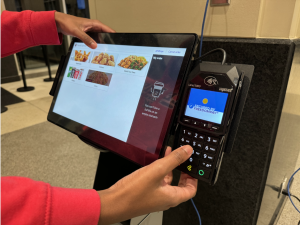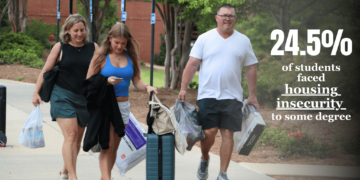
In an effort to increase efficiency and decrease wait times, the Gertrude C. Ford Ole Miss Student Union has been outfitted with sleek, new ordering kiosks.
The long lines at campus-favorite Chick-fil-A and the lines at other union food spots now lead you to a screen where patrons punch in their own order and pay. The new setup also features monitors that display order numbers and wait times for each of the respective restaurants.
Ole Miss Dining, supplied by food service company Aramark, has partnered with GrubHub for the recent renovations to the union, a plan that has been in the works for the past few months.
“We began exploring solutions this summer in anticipation of increased enrollment and in response to feedback we received in focus groups regarding long lines,” Chip Burr, resident district manager with Aramark Higher Education at UM, said. “GrubHub Ultimate provides multiple ordering options from a single platform, which presents our guests with a choice on how to complete transactions.”
Although this partnership was not cheap, Burr explained that the price tag is not unusual.
“The hardware investment was a little over $50,000, which aligns with the industry standard for point-of-sale equipment in such a large retail setting,” he said.
Amid worldwide fears that artificial intelligence and new technology will continue to replace more jobs, concerns arose that the new system would eliminate customer service jobs once held by student workers. This is not the case, according to Burr.
“We retained all previously existing positions and are currently hiring. In fact, we are currently monitoring each location to determine if we need to increase the number of positions,” Burr said.
Though campus jobs are purportedly safe, some students who regularly eat in the union are dissatisfied with the ordering kiosks.
“I don’t like them because you can’t use two meal swipes on one order anymore,” Kylie Clement, a freshman special education major, said.
Others share this struggle. Many students use two meal swipes instead of one to avoid diminishing their Flex dollars early in the semester.
“It’s really a pain that you can’t double up on meal swipes at the kiosks, because that’s usually what I do when I eat at the union,” Ella Blanch, a freshman allied health major from Greenville, S.C., said. “The kiosks just don’t give you the option, and I hate wasting my Flex.”
Another complaint from students is that although the screens display the wait times for each restaurant and have helped to alleviate longer physical lines, many people have observed that actual wait times have stayed the same or are even longer.
“I think it takes longer now and it feels unnecessary to have them in the first place. It seems to confuse people because at some places, you can still order in the line, but you can also order at the kiosk,” Georgia Regan, a freshman criminal justice major from Chicago, said. “I now try to avoid the union as much as I can because of them.”
As with any new technology, there can be a learning curve. Some pointed to unfamiliarity as the reason for persistent wait times, especially within the first few weeks.
“I would say they feel inefficient because people don’t know what to do to use them, so they take longer,” Claire Medley, a freshman integrated marketing communications major, said.
Some, however, feel that these new kiosks are working well and are more efficient than the previous system. Some student employees feel that the process is now quicker and easier than before, save for some drawbacks.
“As an employee, I would definitely say the kiosks have made our lives much more efficient because we no longer have to have someone taking orders,” Kaelin Zoephel, a freshman Blenz Bowls employee, said. “However, it can be a lot when everyone can order at one time from their phones or kiosks, where we used to be able to manage the amount of orders we had at one time. Most of all, I miss the customer interaction.”
Even amidst the confusion and disinterest coming from many students, some are beginning to like the additions for the same reason as the employees: efficiency.
“I think they are a great idea because I don’t have to wait in a line for as long,” Britt Ferguson, a freshman accounting major, said.
In the long run, the coordinators of the new technology hope it eventually benefits all who eat in the union and that more students become accustomed to this new process.
“I am hopeful the campus sees the value in our investment as one that saves time and improves the overall dining experience,” Burr said.


























